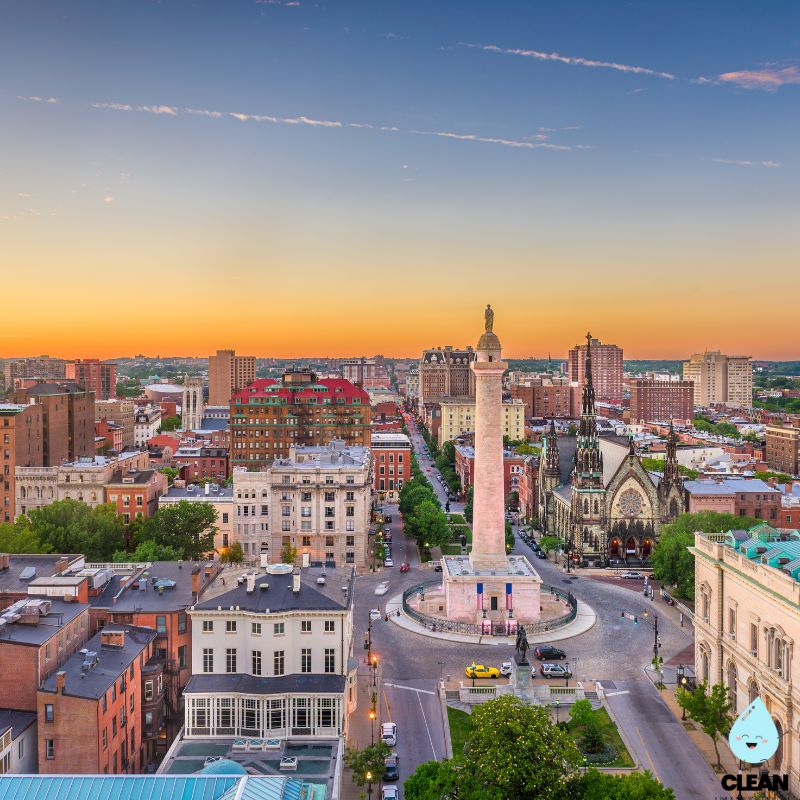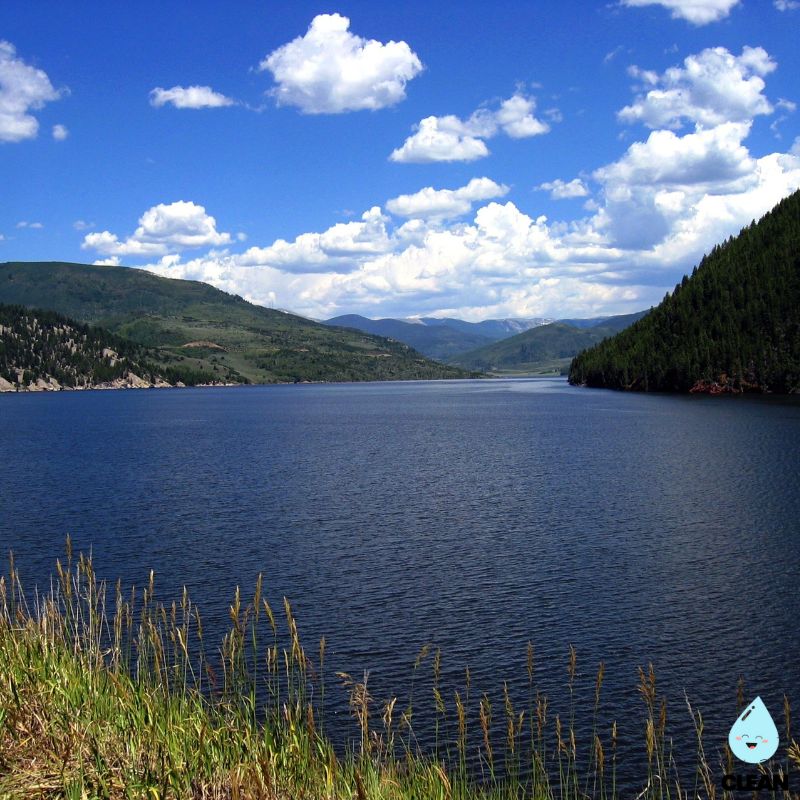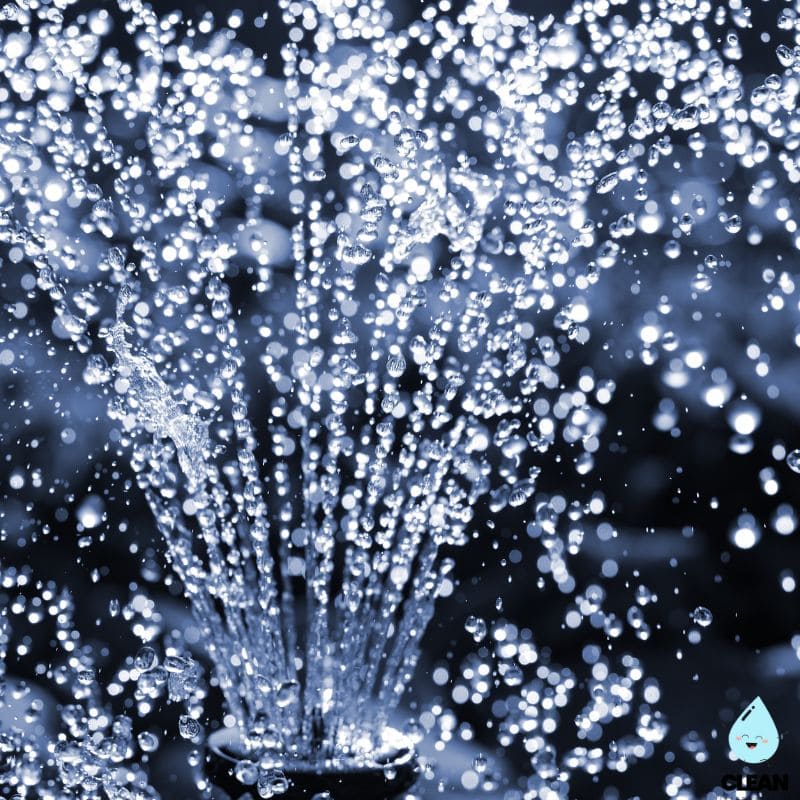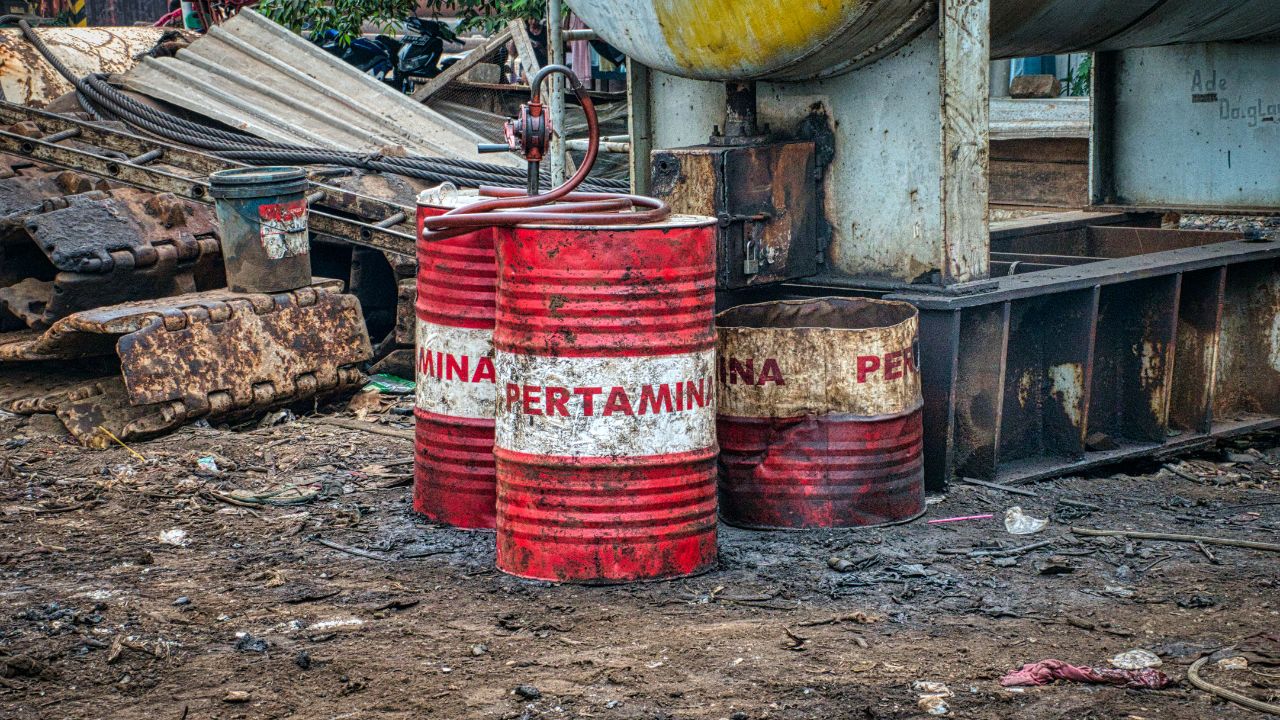Maryland Water Quality at a Glance
notable concerns
Is Maryland Water Safe to Drink?
Generally Yes, With Moderate Concerns – Maryland water systems generally meet federal standards, but the state faces PFAS contamination affecting 41 public water systems with levels exceeding EPA’s new 4 ppt limits. Additional concerns include chromium-6 (averaging 39 ppt in Baltimore), disinfection byproducts, and radium contamination. The state has found PFAS in 75% of tested water treatment plants, with particular concerns around military sites.
⚠️ Key Concerns for Maryland Residents
- PFAS “Forever Chemicals”: 41 public water systems with detections; levels averaging 7.28-18.78 ng/L, exceeding EPA’s 4 ng/L limit
- Treatment Plant Impact: 75% of water treatment plants tested positive for PFAS contamination
- Chromium-6: Baltimore water averaging 39 ppt – nearly double the cancer risk threshold; not federally regulated
- Disinfection Byproducts: Trihalomethanes and haloacetic acids detected at concerning levels in major cities
- School Water Systems: 10 Maryland schools found with PFAS levels exceeding 4 ppt, including one sample 25x the EPA limit
Read the full report below for detailed analysis, city-specific data, and actionable recommendations for Maryland residents.
Maryland – The Old Line State – Water Quality Report 2025: PFAS Testing, Infrastructure Concerns & Safety across your state
Maryland’s water infrastructure serves approximately 6.3 million residents across diverse geographical regions, from the Appalachian Mountains in the west to the Chesapeake Bay in the east. The state operates through a complex network of numerous public water systems, ranging from large regional utilities like WSSC Water, which serves 1.9 million customers across Montgomery and Prince George’s counties, to smaller municipal and private systems providing essential services throughout the state. Maryland’s water sources include the Potomac River system, Chesapeake Bay tributaries, and numerous reservoirs that supply both urban centers and the critical Chesapeake Bay watershed.
Despite abundant water resources from its coastal location and numerous waterways, Maryland faces significant infrastructure challenges. According to the American Society of Civil Engineers’ 2025 Infrastructure Report Card, the nation’s drinking water infrastructure received a C- grade, with Maryland experiencing similar aging system concerns, funding shortfalls, and emerging contaminant issues including widespread PFAS “forever chemicals” contamination. The state has received over $400 million in federal infrastructure investments from the Biden-Harris Administration’s Bipartisan Infrastructure Law to address these challenges, with $18.9 million specifically allocated for emerging contaminants like PFAS, focusing on drinking water safety, wastewater treatment upgrades, and emerging contaminant removal. Maryland’s commitment to water quality improvement is demonstrated through partnerships between the Maryland Department of Environment (MDE), major utilities like WSSC Water and Baltimore City, and federal agencies working to ensure safe, reliable water access for all residents while protecting the vital Chesapeake Bay ecosystem.

Maryland Water Quality: Current Status (2024-2025)
Statewide Compliance and Testing
- Overall Compliance: The majority of Maryland’s public water systems meet federal Safe Drinking Water Act standards, though approximately 41 systems have reported PFAS presence above detection levels, with 75% of tested water treatment plants showing some PFAS contamination requiring monitoring and potential treatment.
- PFAS Monitoring: Maryland has emerged as a leader in PFAS testing and regulation, with comprehensive monitoring programs revealing detectable PFAS concentrations in 75% of tested water treatment plants, with mean concentrations of 7.28-18.78 ng/L significantly exceeding EPA’s 4 ng/L limit, particularly near military installations and industrial sites.
- Infrastructure Investment: Over $400 million in federal funding through the Bipartisan Infrastructure Law has been allocated to Maryland for water infrastructure improvements, with $18.9 million specifically targeting emerging contaminants like PFAS and supporting disadvantaged communities.
Major Water Sources and Challenges
- Potomac River System: Primary source for WSSC Water and Washington metropolitan area, requiring ongoing monitoring for PFAS contamination and protection from upstream pollution sources in Virginia and West Virginia.
- Chesapeake Bay Watershed: Critical water source for eastern Maryland communities, facing challenges from agricultural runoff, urban development, and climate change impacts requiring coordinated regional protection efforts.
- Military Installation Impacts: Significant PFAS contamination documented near Fort Detrick, Fort Meade, Aberdeen Proving Ground, and former Naval facilities, requiring extensive remediation and alternative water source development.
Emerging Contaminant Response
- PFAS Regulation Implementation: New EPA drinking water standards for PFOA and PFOS (4 parts per trillion) take effect in 2029, requiring significant infrastructure investments from affected water systems across the state, with Maryland leading proactive compliance efforts.
- Treatment Technology Deployment: Water utilities are implementing advanced treatment technologies including activated carbon filtration and reverse osmosis systems to remove PFAS and other emerging contaminants, with WSSC Water maintaining its perfect compliance record.
- Legislative Action: Maryland passed the George “Walter” Taylor Act in 2022 restricting PFAS use in food packaging, rugs, carpets, and firefighting foam, with additional legislation under consideration to limit industrial PFAS discharges.
Regional Utility Leadership
- WSSC Water Excellence: As one of the nation’s largest water utilities serving 1.9 million customers, WSSC Water has maintained over 107 years without a drinking water quality violation, setting national standards for utility operations and customer service.
- Advanced Infrastructure: Maryland utilities are deploying smart meter technology, advanced leak detection systems, and predictive maintenance programs to improve efficiency and reduce water loss while preparing for climate change impacts.
- Chesapeake Bay Protection: Coordinated efforts between utilities, environmental agencies, and interstate partnerships ensure that water infrastructure improvements support the ongoing Chesapeake Bay restoration while meeting growing population demands.
Looking Forward: 2025-2030
Maryland’s water quality landscape is positioned for continued excellence as utilities prepare for new federal PFAS regulations taking effect in 2029. The state’s proactive approach to environmental protection, combined with substantial federal infrastructure investments and industry-leading utilities like WSSC Water, positions Maryland as a national model for addressing emerging water quality challenges. However, successful implementation will require continued collaboration between state regulators, regional utilities, and communities to ensure that all Marylanders have access to safe, affordable drinking water while protecting the Chesapeake Bay ecosystem that defines the state’s environmental and economic heritage.
Recommendations for Maryland Residents

Know Your Water Source
Contact your water utility to request annual water quality reports and ask about PFAS testing results. Visit MDE’s website to access your local system’s testing data and understand any contaminants of concern in your area, especially if you live near military installations.

Support Infrastructure Investment
Stay informed about local water infrastructure needs and support utility rate structures that enable necessary improvements. Attend public meetings when utilities discuss infrastructure upgrades and PFAS treatment investments to protect the Chesapeake Bay.

Consider PFAS-Certified Filtration
For areas with known PFAS contamination, particularly near military installations, consider NSF-certified activated carbon or reverse osmosis filters specifically tested for PFAS removal. These can provide additional protection while utilities implement treatment upgrades.

Report Water Quality Concerns
Contact your local water utility immediately for taste, odor, or color concerns. Report suspected contamination to MDE’s Water Supply Program at (410) 537-3084 for investigation and follow-up, or use WSSC Water’s 24/7 emergency line at (301) 206-4002.

Practice Water Conservation
Support Maryland’s water sustainability and Chesapeake Bay protection by implementing conservation measures like efficient irrigation, rainwater harvesting, and low-flow fixtures. Reducing demand helps utilities maintain system reliability while protecting the Bay ecosystem.
Maryland Cities We Cover
Baltimore Water Quality
Comprehensive analysis of Baltimore City water systems, including the Department of Public Works operations, water sources, treatment processes, infrastructure modernization challenges, and PFAS monitoring in Maryland’s largest city.
Frequently Asked Questions
Is Maryland’s tap water safe to drink?
Most of Maryland’s public water systems meet federal drinking water standards and are safe for consumption. WSSC Water has maintained over 107 years without a drinking water quality violation.
The Maryland Department of Environment requires comprehensive testing across all public water systems. While 41 systems have reported detectable PFAS levels, with 75% of tested treatment plants showing some contamination, most utilities are implementing treatment upgrades to comply with new EPA limits. Major utilities like WSSC Water and Baltimore City have invested heavily in treatment technology and infrastructure improvements. The state has received over $400 million in federal funding to address emerging contaminants and infrastructure needs. Residents should review their utility’s annual water quality report and stay informed about local conditions, especially near military installations where PFAS contamination is more common.
What are PFAS chemicals and why are they a concern in Maryland?
PFAS (per- and polyfluoroalkyl substances) are synthetic “forever chemicals” that don’t break down naturally in the environment or human body.
Maryland has documented PFAS contamination in 75% of tested water treatment plants, with concentrations averaging 7.28-18.78 ng/L, significantly exceeding EPA’s 4 ng/L limit. This contamination is primarily linked to military installations like Fort Detrick, Fort Meade, and Aberdeen Proving Ground where firefighting foam was used for decades. These chemicals have been linked to cancer, liver damage, immune system effects, and other health concerns. The EPA finalized new drinking water standards in 2024 limiting PFOA and PFOS to 4 parts per trillion, requiring water systems to comply by 2029. Maryland passed the George “Walter” Taylor Act in 2022 restricting PFAS use and is considering additional legislation to limit industrial discharges into waterways.
How can I find out about my local water quality?
Maryland residents can access comprehensive water quality information through several resources:
• Annual Water Quality Reports: Contact your water utility directly for their Consumer Confidence Report, which details all testing results and any violations or concerns
• MDE Water Supply Program: Visit the Maryland Department of Environment’s online database to access testing results and compliance information for your local water system
• PFAS Testing Data: MDE requires comprehensive PFAS testing and makes results publicly available, especially for systems near military installations
• WSSC Water Resources: For Montgomery and Prince George’s county residents, WSSC Water provides detailed water quality information and maintains interactive maps for service alerts
How does Maryland protect the Chesapeake Bay through water management?
Maryland’s water quality management is closely tied to Chesapeake Bay restoration efforts:
Watershed Protection: All water systems in the Chesapeake Bay watershed must meet strict discharge standards to protect the Bay’s ecosystem and water quality
Advanced Treatment: Maryland utilities employ sophisticated wastewater treatment technologies that remove nutrients and contaminants before discharge to Bay tributaries
Interstate Coordination: Maryland works with Virginia, Pennsylvania, and other Bay states to ensure coordinated water quality protection throughout the watershed
Stormwater Management: Enhanced stormwater controls and green infrastructure help prevent pollution from reaching waterways that flow to the Bay
This integrated approach ensures that water infrastructure improvements support both public health and environmental protection goals that are critical to Maryland’s economy and heritage.
Quality News About Your Water
Get the comprehensive water quality news coverage you need with our dedicated US Water News Service. From coast to coast, we deliver in-depth reporting and expert analysis on PFAS contamination, EPA regulatory changes, infrastructure developments, and emerging water safety issues affecting communities nationwide. While mainstream media only covers the biggest stories, we provide the detailed, ongoing coverage that helps you understand the full scope of America’s water challenges. Whether you’re a concerned citizen, water professional, or community leader, our daily updates and analytical insights keep you informed about the issues that matter most to public health and environmental safety.
Contaminants of Concern

PFAS “Forever Chemicals”
Source: Military installations including Fort Detrick, Fort Meade, Aberdeen Proving Ground, and former Naval facilities where firefighting foam was used for decades; industrial manufacturing and consumer products
Health Effects: Linked to kidney and testicular cancer, liver damage, immune system suppression, high cholesterol, and developmental effects in children
Current Status: Approximately 41 Maryland water systems have reported detectable PFAS levels, with 75% of tested treatment plants showing contamination and mean concentrations of 7.28-18.78 ng/L significantly exceeding EPA’s 4 ng/L limit, requiring ongoing monitoring and treatment upgrades by 2029 EPA Limits: 4 ppt for PFOA and PFOS individually, with hazard index for other PFAS compounds

Chromium-6 and Disinfection Byproducts
Source: Industrial processes, natural mineral deposits, and water treatment disinfection processes; chromium-6 averaging 39 ppt in Baltimore water, with disinfection byproducts including trihalomethanes and haloacetic acids
Health Effects: Chromium-6 linked to cancer and organ damage; disinfection byproducts associated with increased bladder cancer risk and liver, kidney, and central nervous system problems
Current Status: Maryland utilities monitor for chromium-6 with Baltimore averaging 39 ppt (nearly double the cancer risk threshold), while disinfection byproducts are found in major water systems at levels near EPA limits Regulatory Response: Federal chromium-6 standard remains at 100 ppb total chromium; disinfection byproducts regulated under Safe Drinking Water Act
Please read – our information
The information presented on cleanairandwater.net is compiled from official water quality reports, trusted news sources, government websites, and public health resources. While we strive for accuracy and thoroughness in our presentations, we are not scientists, engineers, or qualified water quality professionals.
Our mission is to present water quality information in an accessible, real-world format that helps people understand what’s in their water and make informed decisions about their health and safety. We believe that complex environmental information should be available to everyone in a format that’s easy to understand.
We make every effort to ensure our content is current and accurate, but we cannot guarantee that all information is complete or error-free. This website should not replace official communications from your local water utility or health department. We always recommend consulting official sources for the most up-to-date information regarding your specific water system.
Clean Air and Water is not liable for any unintentional errors, omissions, or outdated information. The content on this site is provided for informational purposes only and should not be considered professional advice.


